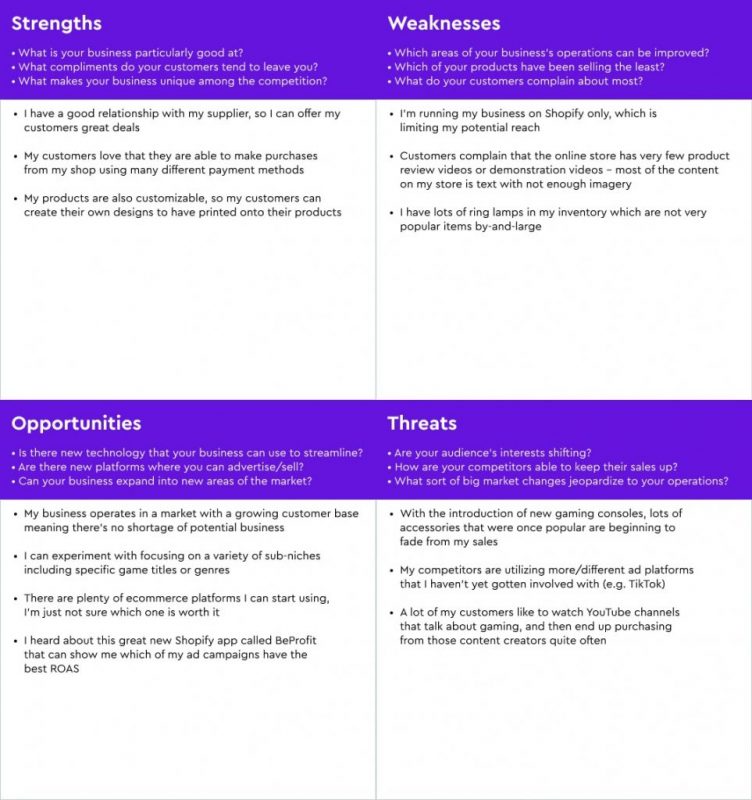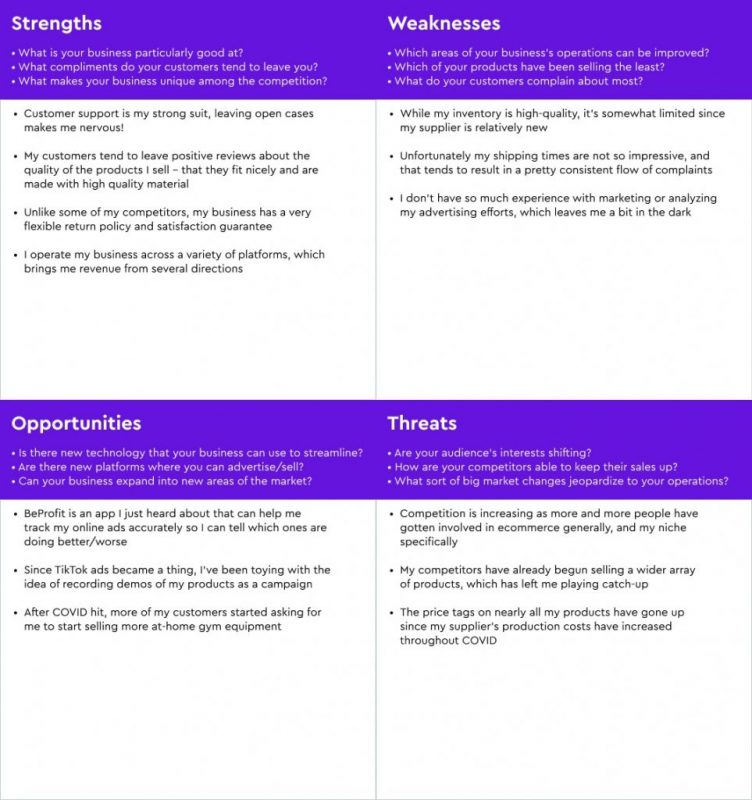What does SWOT stand for?
Sell without thinking?
It’s a good guess, but doesn’t quite hit the mark.
The right answer: Strengths, weaknesses, opportunities, and threats.
But what is SWOT analysis really about? And how does SWOT analysis for online shopping websites work?
Get those answers, and more, as we dive into the world of SWOT analysis.
What is a SWOT analysis in eCommerce?
A SWOT analysis in eCommerce is an assessment of an online business’s strengths, weaknesses, opportunities, and threats (SWOT for short). Running a SWOT analysis for an eCommerce business is not so different from doing it for an offline business – the goals of the process are the same for all businesses: to increase the strengths, reduce the weaknesses, capitalize on opportunities, and avoid threats.
SWOT analysis might not be a familiar term at first, but the ideas are typically intuitive for just about any business owner. While they’re not new or revolutionary, the four parts of SWOT do pack a bigger punch when they’re grouped together within the framework of a structured analysis.
A strong, resilient, and successful business will run a SWOT analysis at least once a year. We’ll give the answer to “how to do a SWOT analysis”, but we should first point out that it can be a lengthy process.
Since it’s not something that you’ll be doing every day, you’ll want to do it right the first time. Consider hiring a professional consultant to run an audit of your business in the form of a SWOT analysis – then you can feel more certain of the insights gained.
But what sort of insights can be gained through a SWOT analysis, anyway? We answer that next.

Why is doing a SWOT analysis important?
At the end of the previous section we mentioned that a SWOT analysis should be run at least once a year. That’s because the e-commerce industry grows and changes at an extremely rapid rate, especially now in the wake of the Coronavirus after so many businesses embraced online commerce more.
Don’t believe us? The fact is that, in 2020, the US ecommerce market grew 44% year over year with online consumers spending in excess of $860 billion – a high water mark that wasn’t expected to be reached until 2022.
In 2020, the US #ecommerce market grew 44% year over year with online consumers spending in excess of $860 billion - a high watermark that wasn’t expected to be reached until 2022.
Click To Tweet
With that in mind, it should go without saying that you’ll need to keep your online business at top-notch performance in order to stay competitive in the ever-changing landscape that is the ecommerce marketplace. Conducting a SWOT analysis for online shopping websites is an extremely useful way to measure performance and spot where and even how to optimize.
It’s a particularly important process because the scope of a SWOT analysis for e business includes both the internal characteristics of that business (i.e. strengths and weaknesses) and the external opportunities and threats.
Side note: Identifying your e-commerce business’s strengths and weaknesses also serves as a way to compare your store with competitors. What are their biggest strengths? What do you notice they can still improve on? Use the answers to those questions to help you establish a firm foothold in your niche.
SWOT matrix example

How to do a SWOT analysis
Running a SWOT analysis is fairly simple on the face of it, but must be given a fair amount of time and attention in order to be done right. You’ll need to stay aware of how the elements of your SWOT analysis relate to each other; rushing through the process will likely end up being a waste, so don’t make that mistake!
Basically, the process of running a SWOT analysis consists of asking yourself questions and then digging into the details of your business to find the answers. This is often done by using a four-quadrant analysis table like the one you see above, but can also be done by simply keeping a list or writing notes with no real format.
In short, there’s no firm answer as to how to do a SWOT analysis other than to ask yourself questions like those in the sections that follow.
Keep reading for more detail on how each part of a SWOT analysis works.
Strengths?
What is your business particularly good at? What sorts of compliments do your customers tend to leave you? What makes your business unique among the competition?
You may have an especially strong commitment to creating a top-notch customer experience. Or you might offer better deals than your customers can find elsewhere. Or perhaps your products are custom-made and one-of-a-kind.
Whatever your strengths are, do everything you can to highlight and promote them so they grow even stronger!
Weaknesses?
Which areas of your business’s operations can be improved? Which of your products have been selling the least? What do your customers complain about most?
Your delivery options may be leaving your customers frustrated with long wait times. You might be wasting money stocking up on inventory that takes way too long to sell. Maybe your customers have been consistently reporting slow website load times or problems with the payment gateway.
Knowing your weaknesses is the first step – focusing energy on bolstering those parts of your businesses is the next step. Just be careful that, in shifting your focus to other weaker areas of your business, you don’t create new blind spots or weak points in your online business.
Side note: One of the most efficient ways to pinpoint which areas of your business need optimization is to track performance across all the different parts of your store. The best way to do that? BeProfit – Profit Tracker.
You can delete the spreadsheets and unsubscribe from other less effective profit tracking tools. BeProfit makes profit and expense calculations effortless, reducing the amount of stress and time it takes to accurately measure your business’s performance.
Learn more about everything that BeProfit does to help you keep accurate tabs on Shopify store’s finances, here.

Opportunities?
Are there new technologies available that your business can use to streamline? Have new platforms been introduced where you can start marketing your business or even selling? Can your business expand into new areas of the market?
With a wide variety of Shopify apps being added all the time, there’s no shortage of opportunities to give your business an edge on the competition. And more generally, the world of ecommerce is constantly evolving – not too long ago the names Shopify and WooCommerce were virtually unknown.
Our point? Keep your eyes peeled for new online platforms, they could be the springboard to your business’s success!
Side note: Other opportunities for your online business could include selling online internationally, diversifying your marketing strategy, and optimizing for m-commerce.
Threats?
Are your audience’s interests shifting away from what you’re currently selling? How are your competitors able to keep their sales up (find out with Koala Apps)? What sort of big market changes are posing a danger to your current operations?
For example, if you advertise your ecommerce store with Facebook Ads, then the recent changes that came along with the iOS14 update doubtlessly pose a threat to how you’re operating on that advertising platform.
Whatever form the threat comes in, the best way to stay aware of things that can drain your profits is to stay up-to-date with ecommerce news and developments. Sign up for newsletters, subscribe to informative and relevant websites, and follow big names in the ecommerce industry so you don’t miss a beat.
Real eCommerce SWOT examples to learn from
As mentioned earlier, a SWOT analysis can be performed in a number of ways. To give you a better idea of how it actually is done, we’ll take a look at a couple examples of how you can potentially run your SWOT analysis.
1. Alex’s Ultimate Electronics
Let’s imagine an online business owner named Alex who runs a Shopify store where he sells electronic gadgets, gizmos, and appliances for video gaming. We can get a clear picture of what Alex’s Ultimate Electronics can improve on, and how it performs in its industry, by using a SWOT table.

Given the results Alex gathered in his business’s SWOT analysis matrix, here are a few points he may take away:
- Customers complain about a lack of review videos, and lots of customers end up purchasing from YouTube channels. Alex can turn this into an opportunity by starting his own YouTube channel where he reviews items, and can then embed those reviews into his store.
- Alex has at least one item that doesn’t sell well at all, and notes that there’s a threat of new products for new gaming consoles. He can run an audit of his inventory to decide which items should go and which new items should take their place, hopefully resulting in better sales.
- Since Alex is only operating on Shopify and he has many other platforms at his disposal, he’s in a great position to test out his different options using their free trial periods without facing much in terms of consequences.
2. Apparel Emporium by Kristen
For our second example, we’ll focus on an online store owned by Kristen that sells women’s sportswear and accessories. The business is actually composed of three stores on three separate eCommerce platforms. How can Kristen’s Apparel Emporium do better and how does it compare to competitors? Let’s use SWOT analysis to find out.

After taking a look back over the SWOT analysis Kristen ran on her business, here’s what we can conclude:
- One of the biggest threats to Kristen’s business is a sharp increase in competition, but she’s been around long enough to rack up a good amount of positive reviews. She can use those reviews on her website to reinforce trust among new customers.
- Production costs are up and so are inventory costs, but more customers are demanding at-home exercise equipment which is already more expensive than apparel. In short, Kristen can expand her market penetration by seizing the opportunity to sell more profitable products.
- With so many positive reviews about the quality of her products, along with her idea to record demo videos, Kristen can amplify the message of offering goods that are satisfaction-guaranteed
SWOT tips and tricks
While we trust and believe that you’ll be able to figure it out for yourself, we’d still like to leave you with a few pointers that you can use to run a proper SWOT analysis your first time around.
1. Use a SWOT matrix. We mentioned earlier that there are a few ways you can run a SWOT analysis, but having the framework of a SWOT matrix will go a long way to help you keep your thoughts organized.
2. Opportunities and threats of ecommerce are out of your control. Although we certainly advise that you prepare for them ahead of time and do your best to mitigate the consequences of threats, you should also come to terms with the fact that sometimes things will go great (or not so great), and there won’t be much you can do about it. That’s the nature of running a business in general.
3. Turn your SWOT analysis strengths and weaknesses into SWOT analysis opportunities. Don’t just accept things at face value. Dig deeper and find ways to make the most of what your business already has. And for those areas that need improvement, seek out opportunities that may exist in your efforts to strengthen those areas of your business.
4. Remember the surfer’s lesson. It’s not enough to simply be on your board in the water and wait for the wave to come. You’ll need to paddle – and paddle hard – to catch and ride that wave. Your business is the surfboard, and the waves are opportunities. While they can often appear to come to you without effort, in order to capitalize on them you’ll need to work for it.
5. Refer to your data for solid answers. Nobody is saying your opinion doesn’t count – it definitely does, especially when we’re talking about your online store. But, the reality is, your perspective doesn’t paint a full picture. Inevitably we all have our blind spots. With all of that said, we all know the old saying that “the numbers don’t lie”. So use them!
Keep accurate track of all your shop data so that you can refer back to it and answer the critical questions posed by SWOT analysis. You can then use your data to create as precise a plan as possible for how to proceed after your analysis is complete.
Ready, SWOT, go!
Nervous about running SWOT analysis? Don’t be! Information is power, and you have a ton of it in this article. Get your business ready to reach new heights – that’s SWOTs up!
|<iframe style="width:120px;height:240px;" marginwidth="0" marginheight="0" scrolling="no" frameborder="0" src="//ws-na.amazon-adsystem.com/widgets/q?ServiceVersion=20070822&OneJS=1&Operation=GetAdHtml&MarketPlace=US&source=ss&ref=as_ss_li_til&ad_type=product_link&tracking_id=coaching054-20&language=en_US&marketplace=amazon®ion=US&placement=B085GM5WMG&asins=B085GM5WMG&linkId=6843153c05bd8c1994d613db6ccb3cca&show_border=true&link_opens_in_new_window=true"></iframe>|_____________________
By: Ben Shabat
Title: How To Do a SWOT Analysis for Your eCommerce Store + 5 Tips & Tricks
Sourced From: www.become.co/blog/swot-analysis-ecommerce-store/
Published Date: Mon, 05 Jul 2021 14:49:32 +0000






